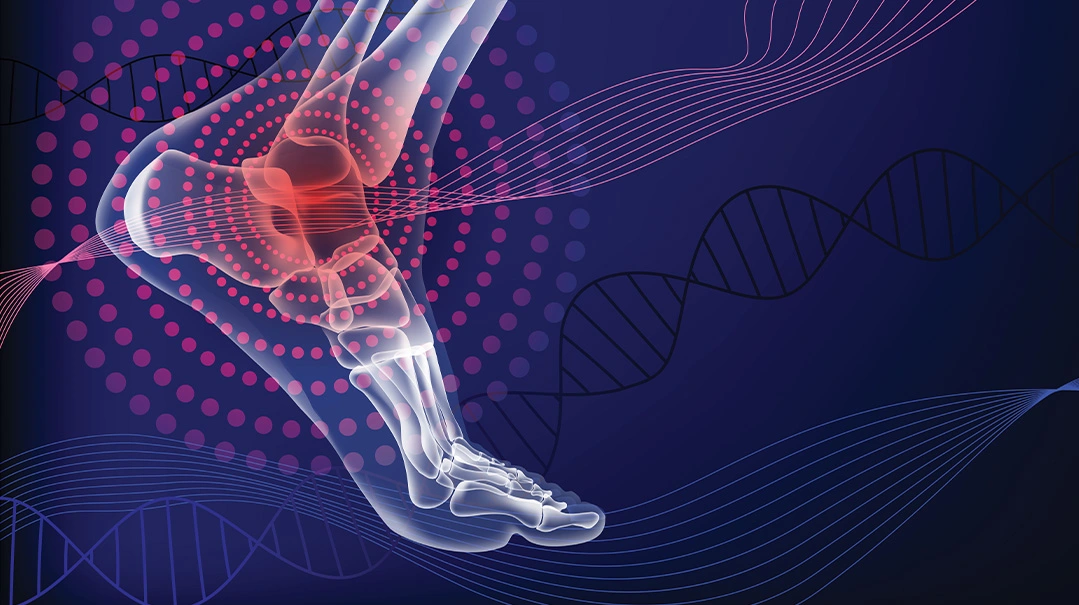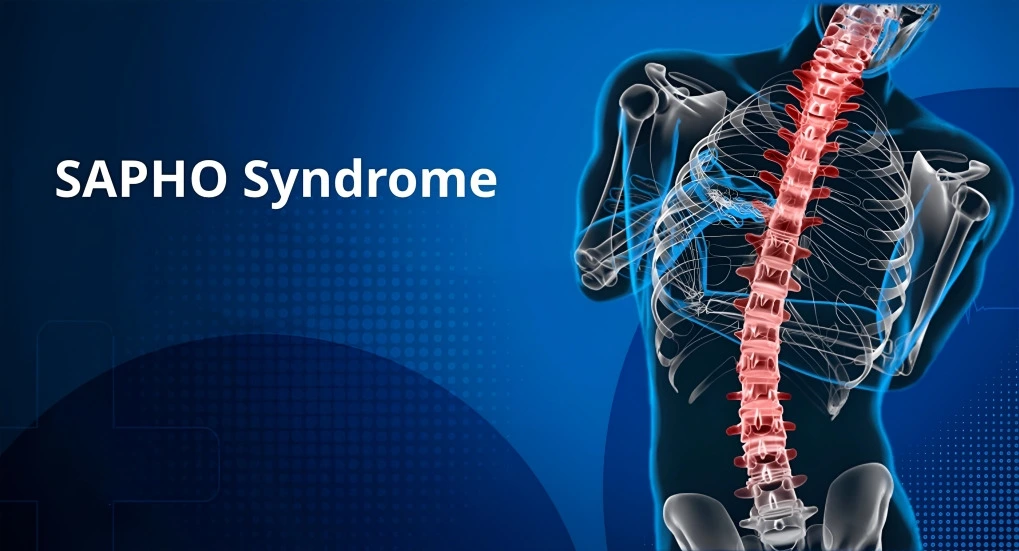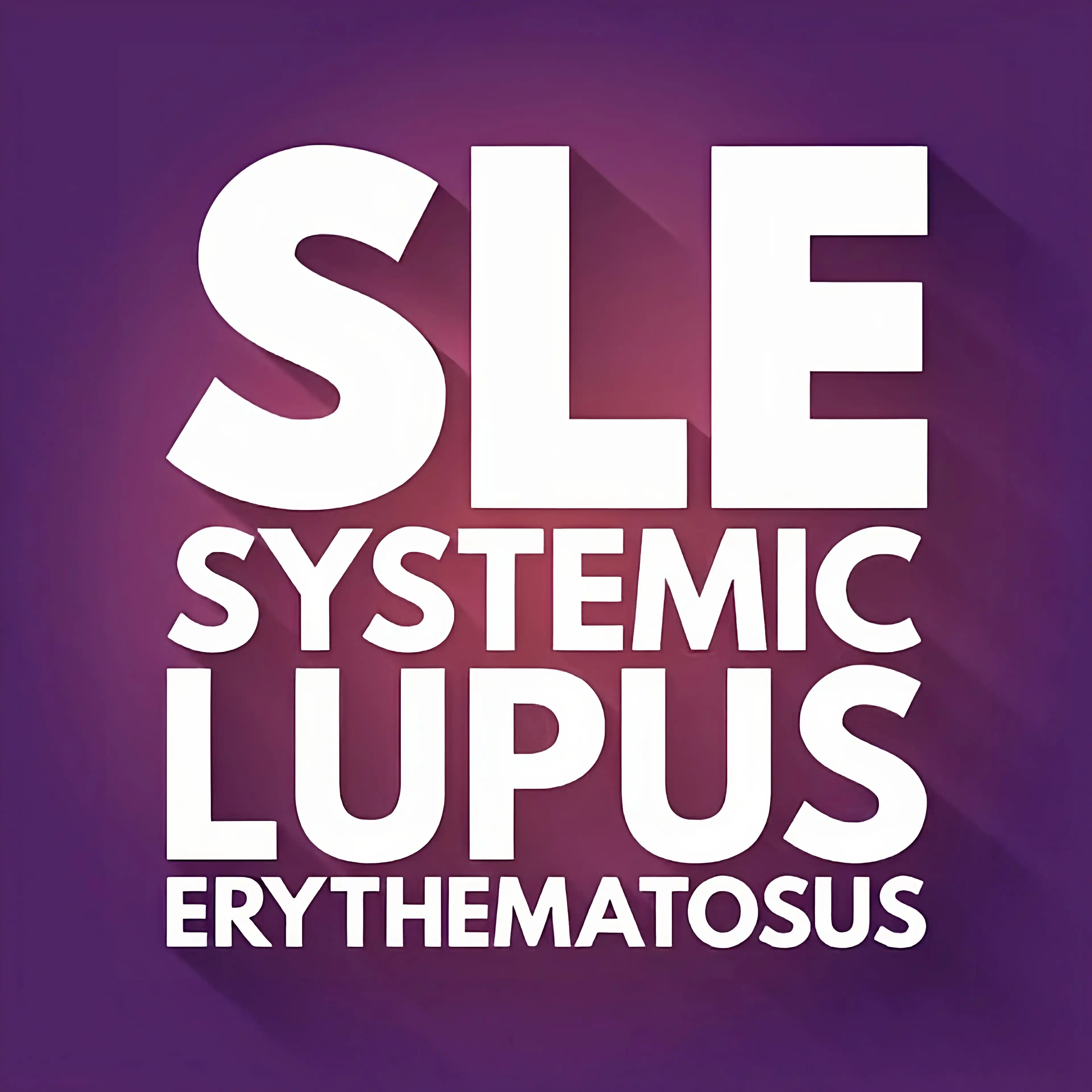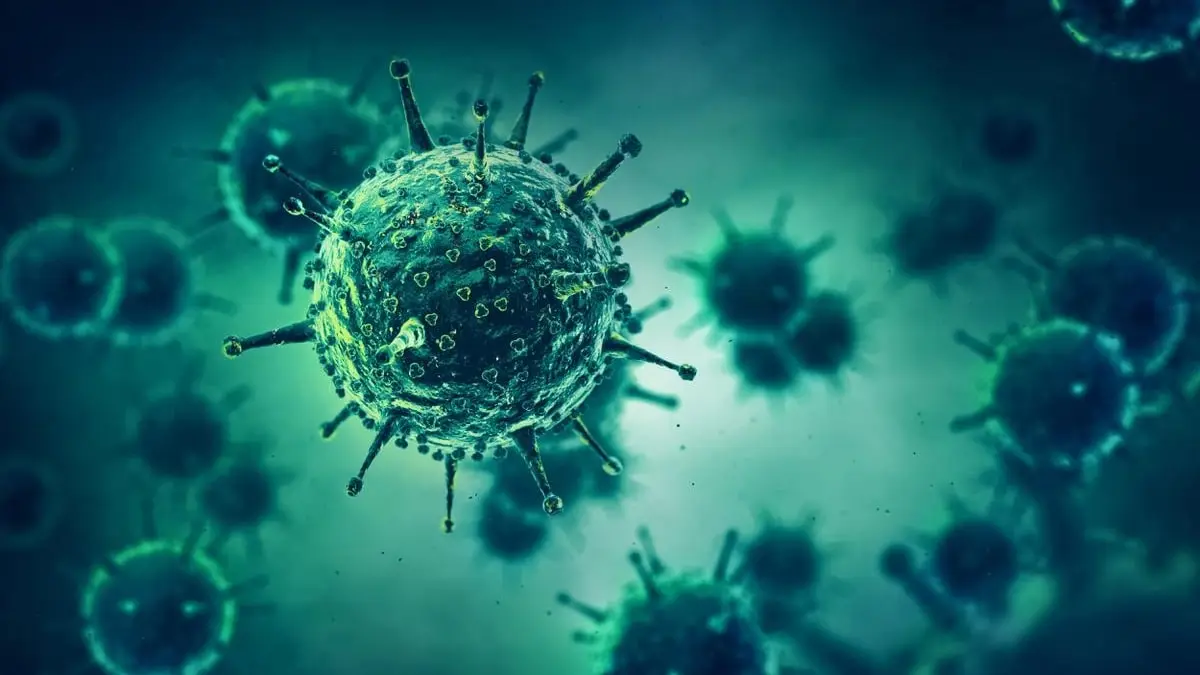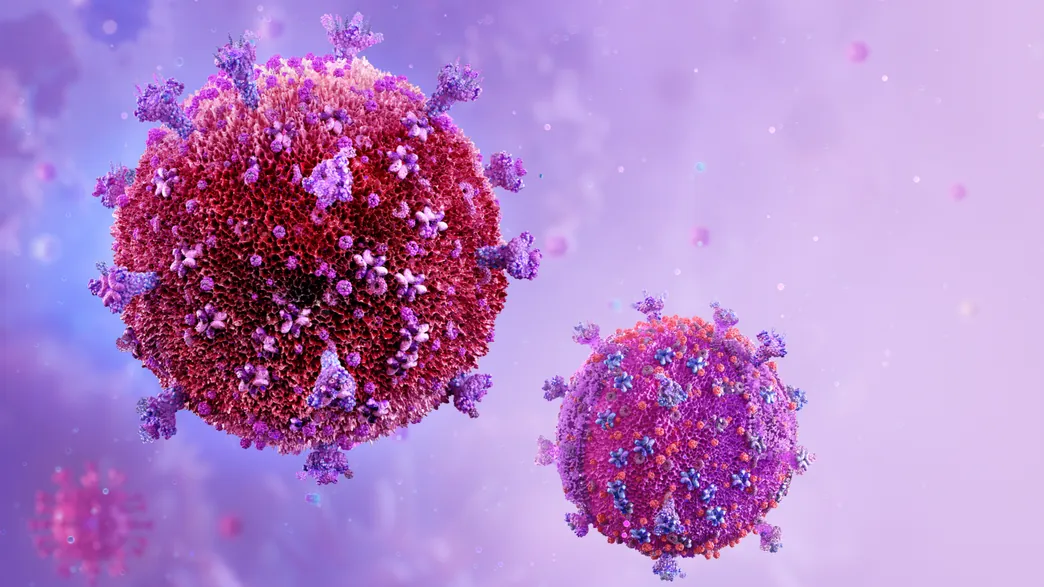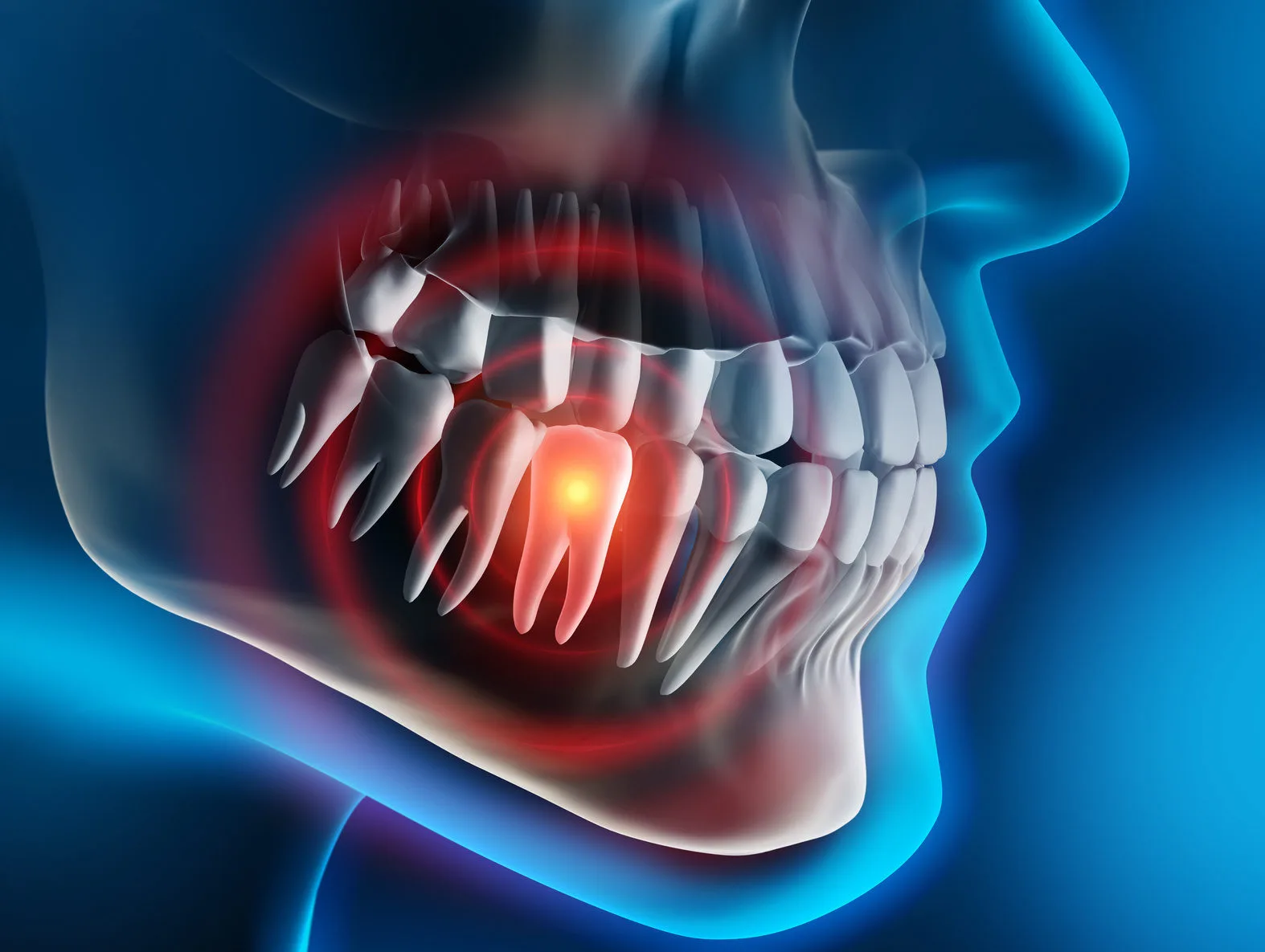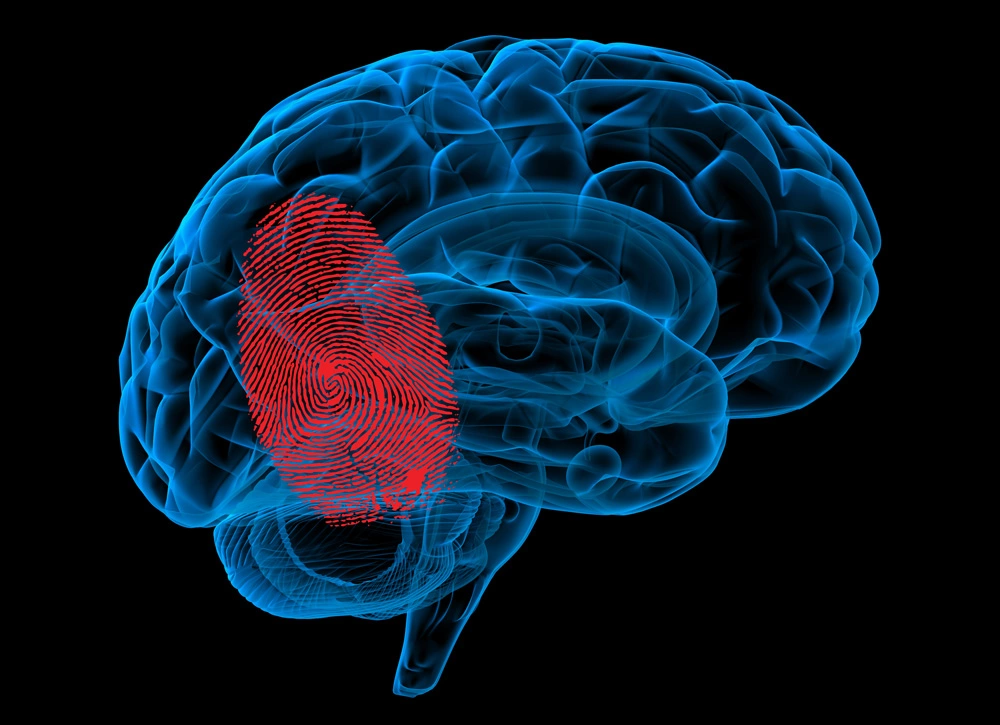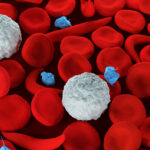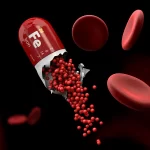Rheumatoid arthritis is a progressive, chronic, and degenerative autoimmune inflammatory disease that is primarily characterized by synovitis.
Systemic Lupus Erythematosus | Causes, Symptoms & Treatments
Introduction
Systemic lupus erythematosus (SLE) is a chronic autoimmune disease that can affect almost any organ system, including the skin, joints, kidneys, nervous system, heart, lungs, and serous membranes.
The clinical presentation of this condition ranges from mild mucocutaneous manifestations to multiorgan and severe central nervous system involvement.
Causes of Systemic Lupus Erythematosus
The cause of SLE is unknown. However, several genetic, endocrine, immunological, and environmental factors play a role in SLE.
Risk Factors of Systemic Lupus Erythematosus
- Gender → SLE primarily affects women of childbearing age, with a female-to-male ratio of 9 to 1.
- Race → The disease is most common among African Americans.
- Age → Although the disease is more prevalent in women of childbearing age, it is also widely reported in children and the elderly population.
- Genetic Factors → The genetic contribution to the development of SLE is considerably high.
- Environmental Triggers
Several drugs have been linked to the development of lupus-like symptoms by causing DNA demethylation and alterations of self-antigens.
There are over 100 drugs that have been linked to drug-induced lupus.
The most common drugs to cause drug-induced lupus are procainamide and hydralazine.
Many medications, including the sulfa-drugs, are well known to lead to flare-ups in SLE patients.
Ultraviolet rays and sun exposure increase cell apoptosis and are well-known triggers for SLE.
Viral infections, particularly Epstein-Barr virus.
Smoking is also considered a risk with a dose-responsive.
Other possible risk factors include silica exposure, vitamin D deficiency, other viral infections, alfalfa sprouts, and foods containing canavanine.
Symptoms & Clinical Manifestations of Systemic Lupus Erythematosus
SLE is a multisystemic disease with various phenotypes.
Clinical manifestations can range from a mild disease with only mucocutaneous involvement to severe, life-threatening disease with multiorgan involvement.
In SLE, any organ system may be affected.
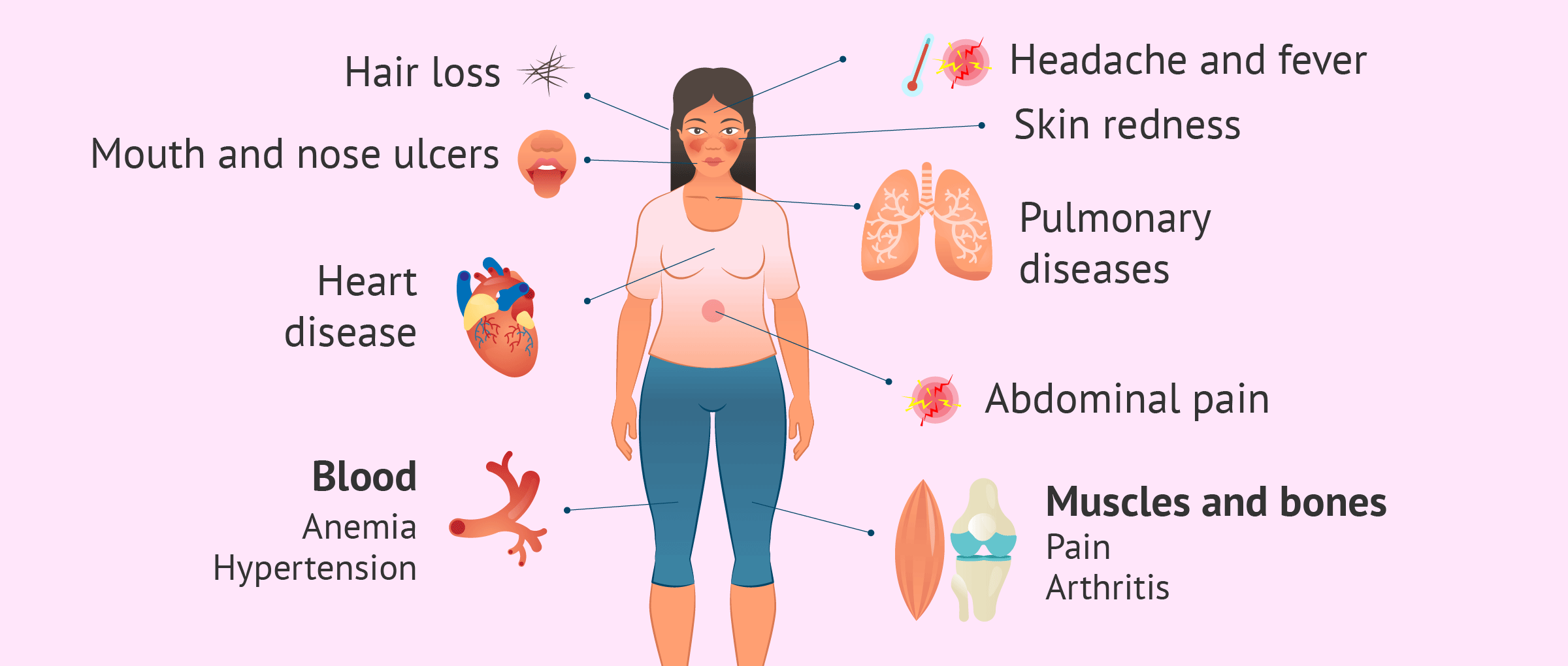
Symptoms of Systemic Lupus Erythematosus
1. Constitutional Symptoms
Constitutional symptoms are present in more than 90% of SLE patients and are frequently the first presenting feature.
- Fatigue.
- Malaise.
- Fever.
- Anorexia.
- Weight loss.
More than 40% of SLE patients may experience fever as a result of a lupus flare.
2. Mucocutaneous Manifestations
Over 80% of SLE patients experience mucocutaneous involvement.
SLE skin lesions could be lupus-specific.
Lupus-specific lesions include: –
A. Acute cutaneous lupus erythematosus (ACLE)
The hallmark of ACLE is the malar rash, also known as the butterfly rash, which is an erythematous raised pruritic rash that affects the cheeks and nasal bridge.
The rash can be macular or papular and does not affect the nasolabial folds (photo-protected).
It usually has an acute onset but can last for several weeks, causing induration and scaling.
The malar rash may change in response to lupus disease activity.
B. Subacute cutaneous lupus erythematosus (SCLE)
The rash is a photosensitive, widespread, non-scarring, non-indurated rash.
SCLE can either have a papulosquamous that resembles psoriasis or it can be an annular or polycystic lesion with central clearing and peripheral scaling.
SCLE lesions may last for several months, but they typically go away without leaving any scars.
SCLE rash occurs in up to 90% of patients who have a positive Anti-Ro (SSA) antibody.
C. Chronic cutaneous lupus erythematosus (CCLE)
The most common type of chronic cutaneous lupus erythematosus (CCLE) is discoid lupus erythematosus (DLE).
DLE can be localized (limited to the head and neck) or generalized (above and below the neck), and it can happen with or without SLE.
The lesions look like disk-shaped erythematous papules or plaques with adherent scaling and central clearing.
DLE heals with scarring and, when present on the scalp, can be associated with permanent alopecia.
The oral cavity can exhibit mucosal DLE lesions, which are typically painful, erythematous, and round lesions with white radiating hyperkeratotic striae.
Other Clinical Manifestations Systemic Lupus Erythematosus
Oral and nasal Ulcers → These are common in SLE and often painless.
Photosensitivity → It is present in more than 90% of SLE cases.
Musculoskeletal Symptoms → Approximately 80 to 90 % of SLE patients experience musculoskeletal symptoms and can range from mild arthralgias to deforming arthritis.
Anemia → It is present in more than 50% of SLE patients, and most commonly is anemia of chronic disease.
Renal Manifestations → The severity of the involvement can range from mild sub-nephrotic proteinuria to diffuse progressive glomerulonephritis that leads to chronic kidney damage.
Pulmonary Manifestations → Pleuritis is the most common pulmonary manifestation, but it is not always accompanied by pleural effusion.
Pregnancy Complications → Patients with SLE who have positive antiphospholipid antibodies are at a higher risk of spontaneous abortions and fetal loss, pre-eclampsia, and maternal thrombosis.
Ocular Manifestations → Eye involvement is common, and keratoconjunctivitis sicca is common in SLE, in the presence or absence of secondary Sjogren syndrome.
Other ocular manifestations include optic neuritis, retinal vasculitis, uveitis, peripheral ulcerative keratitis, scleritis, and episcleritis.
CNS and PNS involvement → SLE may involve both the central (CNS) and peripheral (PNS) nervous systems, in addition to several psychiatric manifestations.
Intractable headaches are the most common CNS manifestation, occurring in more than 50% of cases.
Seizures, either focal or generalized, may occur.
Other CNS manifestations include demyelinating syndrome (including optic neuritis and myelitis), aseptic meningitis, movement disorders like chorea, and cognitive dysfunction.
SLE can affect any layer of the heart, including the pericardium, myocardium, endocardium, and even the coronary arteries.
The most common cardiac manifestation is pericarditis with exudative pericardial effusions.
Gastrointestinal Manifestations → SLE can affect any part of the digestive system.
These manifestations include esophageal dysmotility (especially in the upper one-third of the esophagus), mesenteric vasculitis, lupus enteritis, protein-losing enteropathy, peritonitis and ascites, pancreatitis, and lupoid hepatitis.
Complications of Systemic Lupus Erythematosus
Complications in SLE patients can occur as a result of organ damage caused by the disease or as a result of medication side effects.
1. Disease-related complications
- Anxiety and depression.
- End-stage renal disease.
- Permanent skin damage and alopecia.
- Neurological deficits, including blindness.
- Accelerated atherosclerosis.
- Several pregnancy-related complications, including fetal loss, pre-eclampsia and eclampsia, congenital heart block, and neonatal lupus.
2. Medication-induced complications
a. Long-term corticosteroid use leads to: –
- Poor control of diabetes mellitus.
- Avascular necrosis.
- Acute psychosis.
- Glaucoma.
- Cataract.
- Opportunistic infections.
- Osteoporosis.
- Weight gain.
b. Cyclophosphamide use leads to: –
- Bladder cancer.
- Interstitial cystitis.
Diagnosis of Systemic Lupus Erythematosus
SLE diagnosis can be difficult, and no single clinical feature or lab abnormality can confirm the diagnosis.
Instead, the diagnosis of SLE is made using a combination of the symptoms, signs, and appropriate laboratory tests.
Additionally, histopathology and imaging may be extremely important.
Antinuclear antibodies (ANA) are the disease’s hallmark and should be performed first. The gold standard ANA test is the immunofluorescence assay.
A positive ANA does not confirm the diagnosis of SLE, but a negative ANA reduces the probability significantly.
In patients with SLE or suspicion of having SLE, complement C3 and C4 levels should be checked; low complement levels indicate complement consumption and may be correlated with disease activity.
Inflammatory markers like erythrocyte sedimentation rate and C-reactive protein may be elevated.
To determine the extent of organ involvement, complete blood counts, liver function tests, and renal function tests—including serum creatinine, urinalysis, and urine protein quantification (24-hour urine protein, or spot urine protein/creatinine ratio)—should be performed.
Aspiration of synovial fluid reveals inflammatory fluid. Joint radiographs rarely show erosions but may show peri-articular osteopenia, deformities, or subluxation.
If specific organ involvement is suspected, a computed tomography (CT) scan of the chest, a cardiac workup that includes echocardiography (trans-esophageal when suspecting Libman-Sacks endocarditis), a CNS workup that includes magnetic resonance imaging (MRI), and/or lumbar puncture should be pursued.
If there is a possibility of lupus nephritis, a renal biopsy must always be done. Skin biopsies can be taken into consideration, especially if atypical presentation.
Survival Rate of Systemic Lupus Erythematosus
Despite improvements in SLE treatment options and a better understanding of the disease’s pathophysiology, SLE patients still have a high mortality rate and experience significant morbidity.
A 10-year survival rate is 90.3%, a 15-year survival rate is 88.1%, and a 20-year survival rate is 79.6%.
Renal disease, infections, and cardiovascular disease are the three main causes of death.
Early diagnosis and treatment to prevent organ damage, as well as monitoring and screening patients for cardiovascular disease and infections with early intervention, may improve these outcomes.
Treatment of Systemic Lupus Erythematosus
The goal of SLE treatment is to achieve remission and stop organ damage.
The organ system(s) involved and the degree of involvement determine the type of treatment, which can range from minimal treatment (NSAIDs, anti-malarials) to intensive treatment (cytotoxic drugs, corticosteroids).
a. Education and Disease Awareness
The most important aspects of SLE management are patient education, physical and lifestyle modifications, and emotional support.
Patients with SLE should be well educated about the disease pathology, potential organ involvement, and the importance of medication and monitoring compliance, including brochures.
Exercise, good sleep hygiene, stress management strategies, and emotional support are all encouraged.
Smoking can exacerbate SLE symptoms, so patients should be educated on the importance of quitting.
Dietary recommendations shall include the avoidance of alfalfa sprouts and echinacea, and focus on a diet rich in vitamin D.
Photoprotection is essential. All SLE patients must avoid direct sun exposure by planning their activities carefully, dressing in light-weight, loose-fitting, dark clothing that covers the largest possible area of the body, and applying broad-spectrum (UV-A and UV-B) sunscreens with an SPF of 30 or higher.
b. Therapeutic Treatments of Systemic Lupus Erythematosus
1. Cutaneous manifestations
Mild cutaneous manifestations are usually treated with topical corticosteroids or calcineurin inhibitors such as tacrolimus.
The most effective drug for most cutaneous manifestations is hydroxychloroquine.
If hydroxychloroquine causes intolerance or undesirable side effects, quinacrine may be used. If there is no response to hydroxychloroquine, methotrexate may be used.
Systemic corticosteroids, mycophenolate mofetil (dual benefit with underlying lupus nephritis), and belimumab may be considered for severe or resistant disease.
2. Musculoskeletal manifestations
The first-line treatment for lupus arthritis is hydroxychloroquine.
Methotrexate or leflunomide may be considered if there is no response.
In refractory cases, belimumab and rituximab may be considered.
3. Hematological manifestations
Drug-induced cytopenia must be excluded.
Treatment is typically not needed for mild cytopenia.
Corticosteroids are the mainstay of treatment for moderate to severe cytopenia, and azathioprine or cyclosporine-A can be used as a steroid-sparing agent.
Severe refractory cytopenia can require intravenous pulse dose steroids, mycophenolate mofetil, rituximab, cyclophosphamide, plasmapheresis, recombinant G-CSF, or splenectomy.
4. Cardiopulmonary manifestations
Serositis is usually treated with NSAIDs or moderate to high doses of oral corticosteroids.
Methotrexate and hydroxychloroquine are steroid-sparing agents.
Acute lupus pneumonitis requires high-dose IV pulse corticosteroids, while plasmaphereses and/or cyclophosphamide may be required if diffuse alveolar hemorrhage is present.
Interstitial lung disease can be treated with low to moderate doses of corticosteroids combined with immunosuppressive agents such as azathioprine or mycophenolate mofetil.
Pulmonary arterial hypertension requires vasodilator therapy, whereas thrombotic complications like pulmonary embolism require anticoagulation.
As a result, corticosteroids at high doses are required to treat myocarditis and coronary arteritis.
5. CNS manifestations
Before beginning treatment for neuropsychiatric SLE manifestations, it is very important to perform an accurate diagnosis and rule out other potential causes.
High-dose corticosteroids combined with immunosuppressive agents such as cyclophosphamide, azathioprine, or rituximab are used to treat inflammation-related neuropsychiatric manifestations such as optic neuritis, aseptic meningitis, demyelinating disease, and so on.
In cases of thromboembolic CNS events linked to antiphospholipid antibody syndrome, lifelong warfarin therapy is recommended.
Although there isn’t much evidence, high-dose corticosteroids can be used to treat cognitive impairment.
Renal manifestations: A biopsy is required to confirm the diagnosis of lupus nephritis (LN), rule out alternative causes, and assist in disease classification.
Treatment for Class I and II LN can be treated with renin-Angiotensin-Aldosterone system blockade.
Immunosuppression with high-dose corticosteroids, followed by azathioprine, is recommended only if proteinuria exceeds 1 gram per day.
Membranous LN (class V) should also be treated with renin-angiotensin-aldosterone system blockade.
Class III/IV proliferative LN requires more aggressive treatment.
The first step of induction therapy is IV pulse-dose methylprednisolone, which is followed by high-dose oral steroids combined with mycophenolate mofetil, IV cyclophosphamide, or azathioprine (only in cases of mild disease in whites).
Maintenance therapy with mycophenolate mofetil or azathioprine must be continued for at least three years.
IV pulse cyclophosphamide for one year can be considered maintenance therapy for severe disease.
Some patients may require renal replacement therapy or a transplant.
6. Pregnancy manifestations
Pregnancy should be considered only if the disease was inactive at the time and six months prior due to an increased risk of flares.
The use of progesterone-only contraception is required up until that point.
Hydroxychloroquine should be continued throughout pregnancy because it is thought to be safe during pregnancy and has been linked to a significant decline in disease activity and flare-ups.
For mild symptoms, azathioprine and low-dose corticosteroids can be used.
Other immunosuppressive medications, such as cyclophosphamide, methotrexate, leflunomide, and mycophenolate mofetil, are teratogenic and should not be used during pregnancy.
Belimumab and rituximab should also be avoided during pregnancy.
Before pregnancy, patients with antiphospholipid antibody syndrome should switch from warfarin to low-molecular-weight heparin and aspirin.
Females with positive Anti-Ro or Anti-La antibodies who have a history of neonatal lupus in a previous pregnancy should have close fetal heart monitoring with weekly or alternate-weekly fetal echocardiography during the second trimester.
First or second-degree heart block should be treated as soon as possible with dexamethasone, though prophylaxis with dexamethasone is not recommended.
Hydroxychloroquine lowers the risk of fetal heart block.
7. Other management considerations
Hydroxychloroquine should be used in all SLE patients because it has benefits other than just treating active manifestations, such as anti-thrombotic properties and preventing flares.
Patients taking hydroxychloroquine will need routine ophthalmology exams to check for the rare but permanent maculopathy linked to this medication.
Antibiotic prophylaxis will be necessary for patients taking high doses of corticosteroids to avoid infections.
Summary
Systemic lupus erythematosus (SLE) is a chronic autoimmune disease that can affect almost any organ system, including the skin, joints, kidneys, nervous system, heart, lungs, and serous membranes.
The cause of SLE is unknown. However, several genetic, endocrine, immunological, and environmental factors play a role in SLE.
Clinical manifestations can range from a mild disease with only mucocutaneous involvement to severe, life-threatening disease with multiorgan involvement.
In SLE, any organ system may be affected.
Constitutional symptoms are present in more than 90% of SLE patients and are frequently the first presenting feature.
- Fatigue.
- Malaise.
- Fever.
- Anorexia.
- Weight loss.
More than 40% of SLE patients may experience fever as a result of a lupus flare.
Complications in SLE patients can occur as a result of organ damage caused by the disease or as a result of medication side effects.
SLE diagnosis can be difficult, and no single clinical feature or lab abnormality can confirm the diagnosis.
Instead, the diagnosis of SLE is made using a combination of the symptoms, signs, and appropriate laboratory tests.
Antinuclear antibodies (ANA) are the disease’s hallmark and should be performed first.
Despite improvements in SLE treatment options and a better understanding of the disease’s pathophysiology, SLE patients still have a high mortality rate and experience significant morbidity.
A 10-year survival rate is 90.3%, a 15-year survival rate is 88.1%, and a 20-year survival rate is 79.6%.
The goal of SLE treatment is to achieve remission and stop organ damage.
The organ system(s) involved and the degree of involvement determine the type of treatment, which can range from minimal treatment (NSAIDs, antimalarials) to intensive treatment (cytotoxic drugs, corticosteroids).
How useful was this post?
Click on a star to rate it!
Average rating 0 / 5. Vote count: 0
No votes so far! Be the first to rate this post.
I'm sorry that this post was not useful for you!
Let me improve this post!
Tell me how I can improve this post?
References
- Justiz Vaillant, Angel A., et al. “Lupus Erythematosus.” PubMed, StatPearls Publishing, 2020, from PubMed.
- Systemic Lupus Erythematosus (SLE) – a review of clinical approach for diagnosis and current treatment strategies, from ResearchGate.
- (PDF) Systemic Lupus Erythematosus – from ResearchGate.
- Epidemiology and Survival of Systemic Lupus Erythematosus in Hong Kong. from ResearchGate. Accessed 21 July 2023.
Wang, Z. R., et al. “[Analysis of 20-Year Survival Rate and Prognostic Indicators of Systemic Lupus Erythematosus].” Zhonghua Yi Xue Za Zhi, vol. 99, no. 3, 15 Jan. 2019, pp. 178–182, , from PubMed. Accessed 21 July 2023.
“Systemic Lupus Erythematosus (SLE) Genetics: Practice Essentials, Clinical Implications, Post-GWAS SLE Genetics.” EMedicine, 28 Sept. 2021, from Medscape.
SAPHO syndrome is a chronic immune-mediated condition that affects the skin, joints, and bones.
Systemic Lupus Erythematosus | Causes, Symptoms & Treatments
Systemic lupus erythematosus (SLE) is a chronic autoimmune disease that can affect almost any organ system.
Wiskott-Aldrich syndrome (WAS) is a rare X-linked primary immunodeficiency that is characterized by eczema, recurrent infections, and micro-thrombocytopenia.
Featured Posts
Recent Posts
Popular Posts
Learn More

